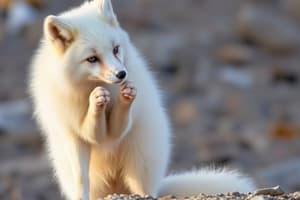Podcast
Questions and Answers
What is the primary function of the thick, white coat of the Siberian fox?
What is the primary function of the thick, white coat of the Siberian fox?
- To regulate body temperature
- To attract mates during breeding season
- To blend in with the Arctic environment (correct)
- To defend against predators
What is the estimated time period during which Siberian foxes evolved from a common ancestor with red foxes?
What is the estimated time period during which Siberian foxes evolved from a common ancestor with red foxes?
- 2-3 million years ago (correct)
- 50,000 to 100,000 years ago
- 10,000 to 20,000 years ago
- 1-2 billion years ago
What is the primary source of food for Siberian foxes?
What is the primary source of food for Siberian foxes?
- Small mammals, such as lemmings and voles (correct)
- Carrion and leftovers
- Fruits and berries
- Seabirds and ptarmigans
What is unique about the circulatory system of Siberian foxes?
What is unique about the circulatory system of Siberian foxes?
What is the typical behavior of Siberian foxes during mating season?
What is the typical behavior of Siberian foxes during mating season?
What is the purpose of denning behavior in Siberian foxes?
What is the purpose of denning behavior in Siberian foxes?
What is the average weight of an adult Siberian fox?
What is the average weight of an adult Siberian fox?
What is the role of Siberian foxes in their ecosystem?
What is the role of Siberian foxes in their ecosystem?
Flashcards are hidden until you start studying
Study Notes
Evolution and Adaptation
- Siberian foxes, also known as Arctic foxes (Vulpes lagopus), are a species of fox that has adapted to survive in the harsh Arctic environment.
- They have evolved from a common ancestor with the red fox (Vulpes vulpes) around 2-3 million years ago.
- Their adaptation to the Arctic environment is characterized by:
- Thick, white coats to blend in with snow and ice
- Small ears and legs to minimize heat loss
- A circulatory system that allows them to survive in extreme cold temperatures
Physical Characteristics
- Body length: 50-60 cm (20-24 in)
- Tail length: 30-40 cm (12-16 in)
- Weight: 3-6 kg (7-13 lbs)
- Coat: Thick, white, and dense in winter; brown and thin in summer
- Eyes: Yellow or orange in color
Diet and Hunting
- Omnivores, feeding on:
- Small mammals (lemmings, voles, and arctic hares)
- Birds (ptarmigans, grouse, and seabirds)
- Fruits, berries, and insects
- Hunting strategies:
- Stalking and pouncing on prey
- Scavenging for carrion and leftovers
Habitat and Distribution
- Found in the Arctic tundra and ice caps of:
- Northern Europe (Norway, Sweden, Finland)
- Asia (Russia, Siberia)
- North America (Canada, Alaska)
- Habitat types:
- Tundra, ice caps, and rocky outcrops
- Areas with low vegetation and abundant prey
Behavior and Social Structure
- Solitary animals, only coming together during mating season
- Territorial behavior, with individuals marking their territory with urine and feces
- Denning behavior, where they burrow into snow and ice to shelter from extreme cold temperatures
- Play an important role in maintaining the balance of Arctic ecosystems
Evolution and Adaptation
- Adapted to survive in harsh Arctic environment through thick, white coats, small ears and legs, and a specialized circulatory system
- Evolved from a common ancestor with the red fox around 2-3 million years ago
Physical Characteristics
- Body length ranges from 50-60 cm (20-24 in)
- Tail length ranges from 30-40 cm (12-16 in)
- Weighs between 3-6 kg (7-13 lbs)
- Coat changes from thick and white in winter to brown and thin in summer
- Eyes are yellow or orange in color
Diet and Hunting
- Omnivores feeding on small mammals, birds, fruits, berries, and insects
- Hunting strategies include stalking and pouncing, as well as scavenging for carrion and leftovers
Habitat and Distribution
- Found in Arctic tundra and ice caps of Northern Europe, Asia, and North America
- Habitat types include tundra, ice caps, rocky outcrops, and areas with low vegetation and abundant prey
Behavior and Social Structure
- Solitary animals that only come together during mating season
- Exhibit territorial behavior through urine and feces marking
- Display denning behavior to shelter from extreme cold temperatures
- Play a crucial role in maintaining the balance of Arctic ecosystems
Studying That Suits You
Use AI to generate personalized quizzes and flashcards to suit your learning preferences.




